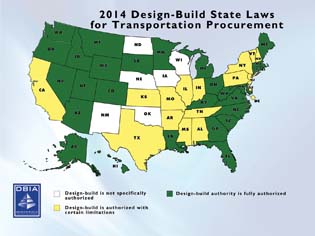by Richard Thomas & Geoff Corey | January 22, 2014
 Every year since DBIA was founded in 1993, the use of design-build has been growing, and 2014 is shaping up to be another year of increased acceptance and use. This unprecedented growth is exactly why design-build can hardly be called “alternative delivery” anymore. For the past three years, the expansion of design-build has mainly been in the transportation sector and local governments. In fact, more than half of the design-build bills passed in 2013 expanded design-build authority for transportation agencies or local governments. That trend is likely to continue in 2014, but we’ll also see greater recognition of the merits of best value selection (as opposed to “low-bid”) and expanded state-funded studies of the design-build process in states that have had design-build authority for a while, and in states just starting to experiment with it.
Every year since DBIA was founded in 1993, the use of design-build has been growing, and 2014 is shaping up to be another year of increased acceptance and use. This unprecedented growth is exactly why design-build can hardly be called “alternative delivery” anymore. For the past three years, the expansion of design-build has mainly been in the transportation sector and local governments. In fact, more than half of the design-build bills passed in 2013 expanded design-build authority for transportation agencies or local governments. That trend is likely to continue in 2014, but we’ll also see greater recognition of the merits of best value selection (as opposed to “low-bid”) and expanded state-funded studies of the design-build process in states that have had design-build authority for a while, and in states just starting to experiment with it.
The most work we have to do is in the Midwest, where many states have zero or limited design-build authority. North Dakota, Iowa and Wisconsin have arbitrary limits that make design-build nearly impossible for public agencies to use. In Missouri, design-build is only allowed in the cities of St. Louis, Columbia and Kansas City, and the Missouri Department of Transportation is only allowed to use it on two percent of its projects. Thankfully, Missouri State Representative Casey Guernsey has introduced H.B. 1212, a bill that will expand design-build authority to any political subdivision, including local governments. We’re also concentrating on Illinois, where current law only allows owners to choose companies for projects based on the lowest bid. This method often leads to either low-quality projects, or costly change-orders midway through projects. The design community in Illinois came to DBIA for help working to pass a bill that would allow owners to choose bids based on best value, which is a DBIA Best Practice. We were already working on similar legislation in Illinois, as well as Indiana, and are happy to have allies in this important fight.
 Two legislative studies on design-build in Oklahoma and Louisiana will have an impact on legislation this year. Following a design-build presentation before the Oklahoma Design-Build Legislative Study Group, a comprehensive design-build/Public-Private-Partnership (P3) bill was introduced by Oklahoma State Representative Richard Morrisette. The bill would expand Oklahoma’s limited design-build authority and authorize design-build and P3s for transportation, which is not currently allowed under Oklahoma law. Similarly, legislation in Louisiana’s 2013 session called for a state panel to study design-build in that state. The legislative study group took testimony from state-wide and national stakeholders including DBIA. The study was conducted through the summer and fall of 2013 and the panel is expected to make recommendations to the legislature this year based on those results.
Two legislative studies on design-build in Oklahoma and Louisiana will have an impact on legislation this year. Following a design-build presentation before the Oklahoma Design-Build Legislative Study Group, a comprehensive design-build/Public-Private-Partnership (P3) bill was introduced by Oklahoma State Representative Richard Morrisette. The bill would expand Oklahoma’s limited design-build authority and authorize design-build and P3s for transportation, which is not currently allowed under Oklahoma law. Similarly, legislation in Louisiana’s 2013 session called for a state panel to study design-build in that state. The legislative study group took testimony from state-wide and national stakeholders including DBIA. The study was conducted through the summer and fall of 2013 and the panel is expected to make recommendations to the legislature this year based on those results.
Finally, we’re excited to report that we’re also working to pass a comprehensive design-build law in our nation’s most populous state: California. Current California law is very complicated because at different times in California’s history multiple laws have passed authorizing certain agencies and local governments to use design-build. There are differing restrictions, however, on each agency or local entity. The bill we’re working on would repeal the different authorizations and enact one set of provisions that would authorize the Department of General Services, the Department of Corrections and Rehabilitation and those local agencies to use design-build for specified public works. This streamlining would be a welcome relief to owners and practitioners alike who have had difficulty managing the web of differing restrictions, especially when working in overlapping jurisdictions or with two agencies where only one has design-build authority. As California’s population continues to boom, they will need a more robust infrastructure, and design-build authority will allow them to build more schools, bridges or even high speed rail in less time with greater innovation and quality.
The growth of design-build since DBIA’s founding over 20 years ago has been absolutely remarkable. Design-build is now the delivery method of choice in nearly 40 percent of non-residential projects, which is the direct result of the massive expansion in design-build authority we’ve seen on the state and local level. If we continue at our current pace, 2014 is set to be a banner year for legislative achievements, with some states accepting design-build for the first time, others clarifying their current laws and some even beginning to make design-build the standard project delivery method for public works. Be sure to check back to Design-Build-Blog for updates on all of our 2014 advocacy efforts.
